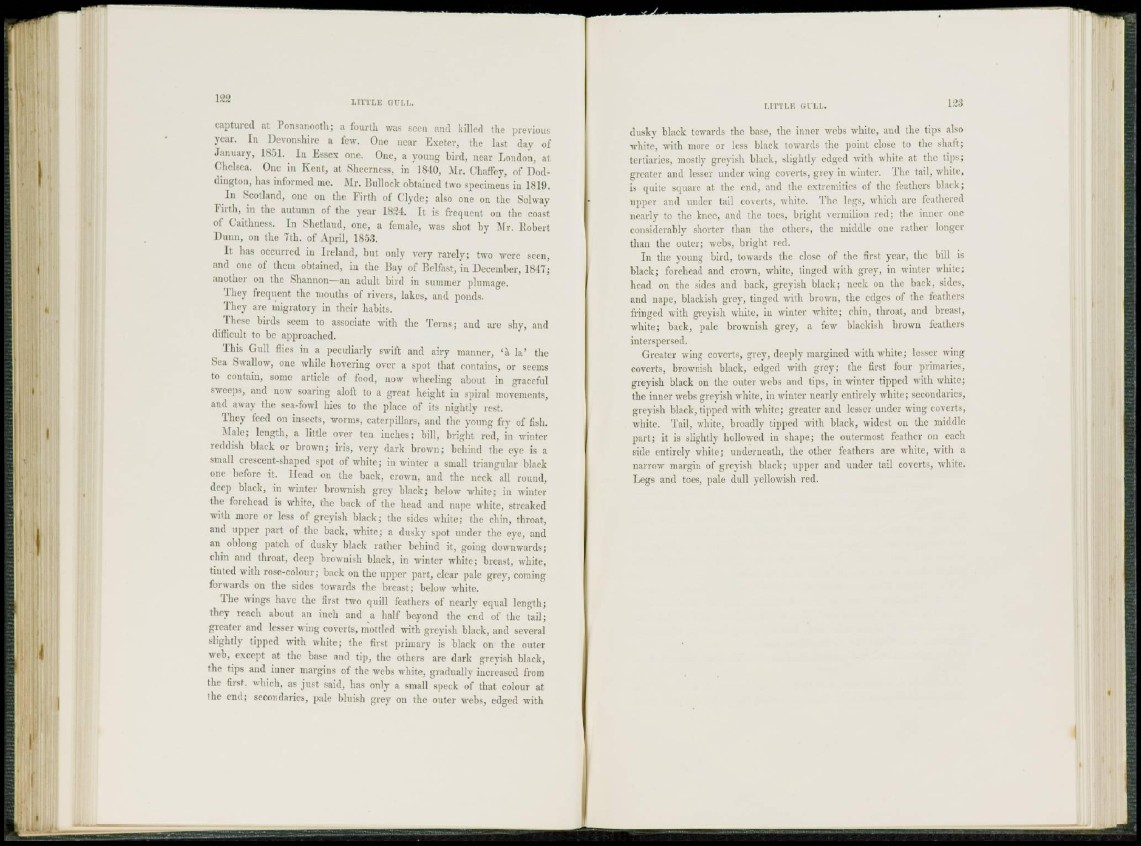
122 LITTLE GULL.
captured at Ponsanooth; a four ill was seen and killed the previous
year. In Devonshire a few. One near Exeter, the last day of
January, 1851. In Essex one. One, a young bird, near London, at
Chelsea. One in Kent, at Sheerness, in 1840, Mr. Chaffer, of Doddhigton,
has informed me. Mr. Bullock obtained two specimens in 1819.
In Scotland, one on the Firth of Clyde; also one on the Solway
Firth, in the autumn of the year 1824. It is frequent on the coast
of Caithness. In Shetland, one, a female, was shot by Air. Robert
Dunn, on the 7th. of April, 1853.
I t lias occurred in Ireland, hut only very rarely; two were seen,
and one of them obtained, in the Bay of Belfast, in December, 1847;
another on the Shannon—an adult bird in summer plumage.
They frequent the mouths of rivers, lakes, and ponds.
They are migratory in their habits.
These birds seem to associate with the Terns; and are shy, and
difficult to be approached.
This Gull flies in a peculiarly swift and airy manner, r a la' the
Sea Swallow, one while hovering over a spot that contains, or seems
to contain, some article of food, now wheeling about in graceful
sweeps, and now soaring aloft to a great height in spiral movements,
and away the sea-fowl hies to the place of its nightly rest.
They feed on insects, worms, caterpillars, and the young fry of fish.
Male; length, a little over ten inches; hill, bright red, in winter
reddish blaek or brown; iris, very dark brown; behind the eye is a
small crescent-shaped spot of white; in winter a small triangular black
one before it. Head on the back, crown, and the neck all round,
deep black, in winter brownish grey black; below white; in winter
the forehead is white, the back of the head and nape white, streaked
with more or less of greyish black; the sides white; the chin, throat,
and upper part of the back, white; a dusky spot under the eye, and
an oblong patch of dusky black rather behind it, going downwards;
chin and throat, deep brownish black, in winter white; breast, white,
tinted with rose-coloxir; back on the upper part, clear pale grey, coming
forwards on the sides towards the breast; below white.
The wings have the first two quill feathers of nearly equal length;
they reach about an inch and a half beyond the end of the tail;
greater and lesser wing coverts, mottled with greyish black, and several
slightly tipped with white; the first primary is black on the outer
web, except at the base and tip, the others are dark greyish black,
the tips and inner margins of the webs white, gradually increased from
the first, winch, as just said, has only a small speck of that colour at
the end; secondaries, pale bluish grey on the outer webs, edged with
LITTLE GULL. 123
dusky black towards the base, the inner webs white, and the tips also
white, with more or less black towards the point close to the shaft;
tertiaries, mostly greyish black, slightly edged with white at the tips;
greater and lesser under wing coverts, grey in winter. The tail, white,
is quite square at the end, and the extremities of the feathers black;
upper and under tail coverts, white. The legs, which are feathered
nearly to the knee, and the toes, bright vermilion red; the inner one
considerably shorter than the others, the middle one rather Longer
than the outer; webs, bright red.
I n the young bird, towards the close of the first year, the bill is
black; forehead and crown, white, tinged with grey, in winter white;
head on the sides ami hack, greyish black; neck on the back, sides,
and nape, blackish grey, tinged with brown, the edges of the feathers
fringed with greyish white, in winter white; chin, throat, and breast,
white; back, pale brownish grey, a few blackish brown feathers
interspersed.
Greater wing coverts, grey, deeply margined with white; lesser wing
coverts, brownish black, edged with grey; the first four primaries,
greyish black on the outer webs and tips, in winter tipped with white;
the inner webs greyish white, in winter nearly entirely white; secondaries,
greyish black, tipped with white; greater and lesser under wing coverts,
white. Tail, white, broadly tipped with black, widest on the middle
part; it is slightly hollowed in shape; the outermost feather on each
side entirely white; underneath, the other feathers are white, with a
narrow margin of greyish black; upper and under tail coverts, white.
Legs and toes, pale dull yellowish red.